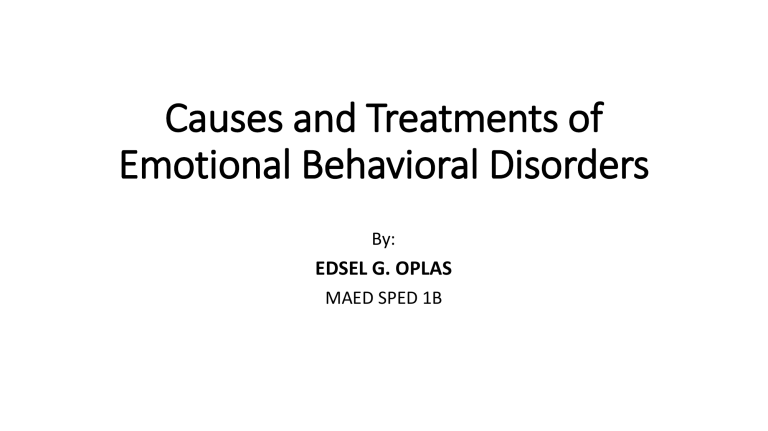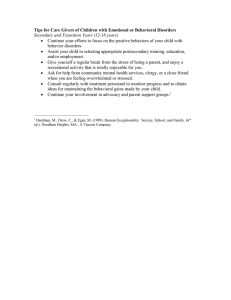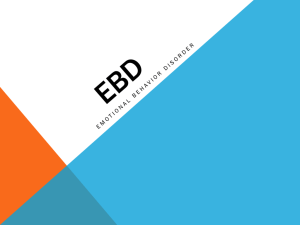Emotional Behavioral Disorders: Causes, Treatments, and Diagnosis
advertisement

Causes and Treatments of Emotional Behavioral Disorders By: EDSEL G. OPLAS MAED SPED 1B There are a few root causes of emotional and behavioral disorders, which include instability in home life, a history of trauma or adverse childhood experiences, and family history of behavioral or psychiatric conditions. Causes of Emotional and Behavioral Disorders It is believed that some of the risk factors and potential causes for EBD include instability in home life, traumatic or adverse experiences, and history of behavioral disorders within the family of the person suffering. Past physical, sexual, or psychological abuse are risk factors for EBD. Other factors which increase the possibility of developing EBD include: Malnutrition include overweight, underweight, obesity, inadequate vitamins and minerals. Substance abuse during pregnancy of the biological mother Too rigid or too lenient of parenting style, parenting style can affect everything from your child's self-esteem and physical health to how they relate to others. Neglect, is an act of caregivers (e.g., parents) that results in depriving a child of their basic needs, such as the failure to provide adequate supervision, health care, clothing, or housing, as well as other physical, emotional, social, educational, and safety needs Treatment for EBD depends on both the type and severity of the EBD. Assessment and planning an individualized approach are the best methods of practice for the treatment of EBD currently. This can include interventions made by the school in the form of an IEP, or an Individualized Education Plan. IEP's are created by a multidisciplinary approach in which a school psychologist, the student's teachers, and sometimes other related professionals discuss and formulate appropriate interventions to help the student with an emotional disability. Social skills training and parenting education may also be helpful. Sometimes therapy and psychotropic pharmaceuticals are utilized if the student has a more severe emotional disturbance. Psychotropic medications are used to treat mental health disorders. There are five main types of psychotropic medications, and each type has its own specific uses, benefits, and side effects. The doctor can help you decide which psychotropic medication is right for the student. The Individuals with Disabilities Education Act, or IDEA, is a federal law enacted with the intention of protecting the rights of students with disabilities. In order to be considered to have an _emotional disturbance (which is how IDEA classifies emotional or behavioral disorders), according to IDEA, at least one of the following diagnostic criteria must be met: Learning difficulty not attributed to intelligence, health, or sensory factors Inability to experience happiness most of the time Difficulties with peer and/or adult relationships Development of medical problems routed in psychological problems Unacceptable behaviors present in the classroom or other settings Diagnosis It is important to consult a mental health professional if a child may have a behavioral disorder. A specialist can diagnose the disorder through an assessment process. This may include: • • • • child observation behavior checklists standardized questionnaires interviews with parents, caregivers, or teachers It is not possible for parents or caregivers to diagnose behavioral disorders themselves. An early diagnosis can significantly improve the effectiveness of treatments. But many child psychologists will not diagnose a behavioral disorder in very young children, particularly those of preschool age or younger. This is because it can be challenging to distinguish between normal and abnormal behavior in this age group. Over 80% Trusted Source of preschoolers have mild tantrums occasionally. Because young children experience huge developmental changes in a short period of time, they may outgrow short-term behavioral difficulties. The management of behavioral disorders can vary depending on the child’s needs, their family’s needs, and the type and severity of their disorder. Approaches that may help include: Parent management training: This helps parents and caregivers manage their child’s behavior, learn effective ways of communicating with them, and effective ways of setting rules and boundaries. For young children, this is often the main approach. Individual therapy: This can help older children and adolescents learn techniques for managing their emotions and responding to stressful situations. Family therapy: This may help household members learn how to talk to each other about emotions and problems, and find ways to solve them. Social or school-based programs: These programs help children and adolescents learn how to relate to peers in a healthy way. Support for learning difficulties or disabilities: Professional support with learning difficulties may improve the child’s well-being and help them get on better at school. Medication: If a child has a coexisting disorder, such as ADHD or a mental health condition, medication can reduce the symptoms. But medications do not cure behavioral disorders. Caregivers should speak with a pediatrician if they think their child may be showing signs of a behavioral or developmental disorder. The doctor may refer the child to a specialist, such as a: developmental-behavioral pediatrician child psychologist child psychiatrist pediatric neurologist Sources: https://www.healthyplace.com/parenting/behaviordisorders/what-causes-emotional-and-behavioral-disorders https://study.com/academy/lesson/emotional-behavioral-disordersdefinition-characteristics-causes.html https://www.medicalnewstoday.com/articles/behavioral-disorders-inchildren#diagnosis






